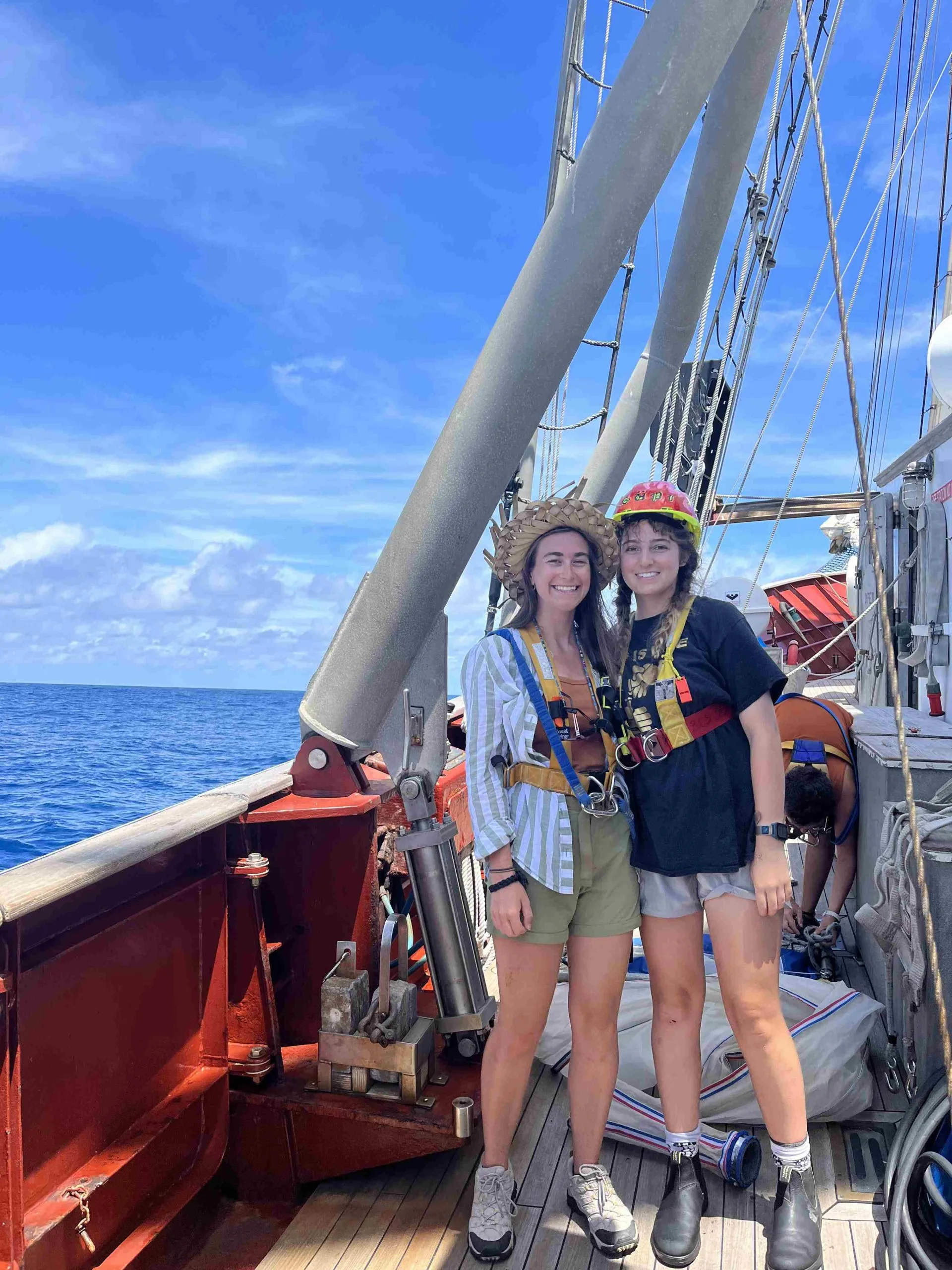Programs Blog
Exploring Plankton’s Colorful World

July, 21, 2023
Abby Grassick, Visiting Scientist/Fish Specialist
Ship’s Log
Location
00° 44.0’ N x 176° 44.2’W, 4 miles off the coast of Howland Island
Weather
Easterly winds of about 6 knots. Low cloud cover; a bright and sunny day.
I have always found lab spaces to be comforting; neatly arranged pipette tips line cabinets, glassware sits on shelves organized by size, microscopes line open bench tops, and there is often a whir of computer equipment. Sometimes these aspects change depending on your lab; while doing coral research, I was acquainted with the sounds of rushing water filling our aquariums, in micro labs, there is a steady hum as an autoclave pressurizes and depressurizes to sterilize samples. I have worked in many labs in my life, but no experience has quite compared to my experiences in lab onboard the Robert C. Seamans.A ship lab is brought to life by the energy of the waves around it. Vials rock back and forth in their racks, never quite comfortable as the ship rolls back and forth, clinking together faintly. The fan roars in the dry lab in an effort to keep our computers and equipment cool in spite of the blazing heat and humidity outside. The J-frame buzzes to life during our deployments, and there is often shouting heard on the science deck as commands are given and repeated.My name is Abby Grassick, and I am a visiting researcher from the Rotjan Lab at Boston University and the Blue Nature Alliance. My colleague, Allie Cole (who is very much not the same person as me, despite some confusion on board), and I were sent on this voyage to collect data on larval fish ecology in marine protected areas. Our research focuses on co-associations among fish and other plankton during their fragile and volatile early life stages in an effort to better understand the role they play in their ecosystems.The starkest difference between my work on land and at sea, however, has to be the amount of life we see in our samples. Back at BU, our samples are anywhere from months to years old. The ethanol they are stored in has withdrawn all of their lipids, taking their vibrancy with them. Things sit still as you peer at them through the scope- generally behaving better. I have grown accustomed to the sad, colorless world of samples preserved in a time long ago; on the ship, however, our scopes are filled with bright colors and life. Copepods dance in our nets with deep blue hues; iridescent plankton shimmer purple, pink, and green in our nets. Our buckets glow a deep turquois at night when disturbed as bioluminescent pyrosomes signal their contempt for being caught in our nets.Plankton are truly aliens of the ocean- sporting long tentacles to resist gravity, false eyes near their tails to avert predation, or large claws used for eating the guts of salps and other gelatinous creatures. Occasionally, our tows will pull up some grotesque looking fish from the deep, which we work diligently to identify using our guide books (there is no Google in the central Pacific!) or the wires from our nets will catch large, 50-foot pelagic worms that flutter in the wind towards the science deck (an experience which student Caleb Fineske cites “grasped with such disgust that such creature has the audacity to exist on the same planet as ”).After being bio-volumed and processed, we package up our samples in ethanol to be sent back to BU to be sorted through by our lab mates. As we fill our jars with ethanol, I watch as the color of all of the plankton fades once more into the muted whites and beiges of which I have come accustomed.My time on the Seamans has been filled with lots of fun, friendships, and of course, plankton. I am so honored to be a part of a crew that loves the oceans as much as me, and shares a passion for plankton as I do. We are doing important work on board this good ship, and the samples we collect here will be used to inform the establishment of future marine protected areas for years to come.I want to give a very special shout out to my mentor Randi Rotjan for providing me with this amazing opportunity. You and your work with the Blue Nature Alliance is such an inspiration to me and everyone else on board.To my family: Hi!!! I am alive and well and thriving out here. I love you and miss you all.To Supi’s parents: Hi!!!! Thanks for reading.To Andrew: I miss you!! We are seeing lots of birds- I can’t wait to have a superior e-bird upon my return. Give Tifton a big kiss for me.
 Abby and Allie showing off an unidentified fish during class
Abby and Allie showing off an unidentified fish during class
 Abby sorting a night time tucker trawl in the wet lab
Abby sorting a night time tucker trawl in the wet lab
Recent Posts from the Ships
- Ocean Classroom 2024-A collaborative high school program with Proctor Academy
- Collaborations and Long-term Commitments: SEA’s Caribbean Reef Program Sets a Course for Coastal Programs that Compliment Shipboard Experiences.
- Sea Education Association students prepare for life underway using state of the art nautical simulation from Wartsila Corporation.
- SEA Writer 2022, Magazines From the Summer SEA Quest Students
- Technology@SEA: Upgrades Allow Insight into Ocean Depths
Programs
- Gap Year
- Ocean Exploration
- High School
- Science at SEA
- SEA Expedition
- SEAScape
- Pre-College
- Proctor Ocean Classroom
- Protecting the Phoenix Islands
- SPICE
- Stanford@SEA
- Undergraduate
- Climate and Society
- Climate Change and Coastal Resilience
- Coral Reef Conservation
- Marine Biodiversity and Conservation
- MBL
- Ocean Exploration: Plastics
- Ocean Policy: Marine Protected Areas
- Oceans and Climate
- Pacific Reef Expedition
- The Global Ocean: Hawai'i
- The Global Ocean: New Zealand